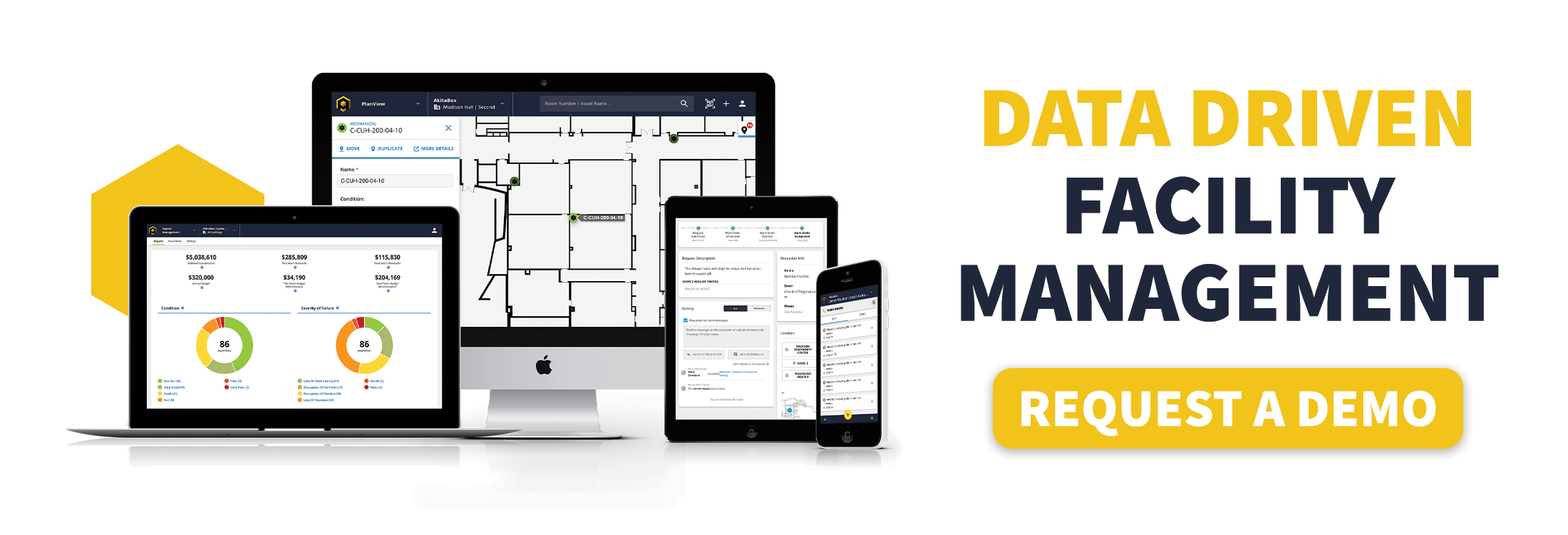Having accurate square footage in a facility is an absolute must, but many facilities haven’t had updated measurements since their buildings were created. Inaccurate square footage metrics can lead to major issues, including complications with building projects and excess spending across multiple facilities.
Now is the time to calculate your building’s accurate space data for more efficient maintenance and operations. Here are the definitions and calculations of four common types of square footage: gross square footage, net square footage, net assignable square footage and net cleanable square footage. By gathering these metrics, you’ll be better prepared to perform preventive maintenance in your facility and save money for your department.
1. What is Gross Square Feet?
Gross Square Feet (“GSF”) refers to the total enclosed square footage of a building as measured from exterior walls. It is an umbrella term for all areas included in a facility. It can be helpful to think of GSF as the culmination of everything found within a building’s walls, sort of like the general space within a box that you could pack something into.
GSF is commonly used in planning and budgeting for construction, operations and maintenance. It’s also considered an important metric for benchmarking for operations and maintenance.
How to Calculate Gross Square Footage
Calculating gross square footage is simple. Calculate the exterior dimensions of your building, as demonstrated in the above graphic. Measure the length and width of the building’s walls. Multiply the length and width measurements to find square footage. Remember to multiply the square footage times the number of floors in the building if your facility has more than one floor.
2. What is Net Square Feet?
Net Square Feet (“NSF”) is like gross square feet, minus space that is inaccessible to people. In other words, NSF would include areas that people can walk into, like offices, classrooms, hallways, stairwells and closets. NSF would not include space that is taken up by walls, or mechanical chases that are closed off between walls or floors.
NSF is a great metric to use when determining circulation, capital planning for renovations and mechanical area locations. NSF isn’t readily available in most facilities and can be difficult and time consuming to collect. This usually turns facility managers away from assigning someone to measure it out. The introduction of space management software can help alleviate this issue and accomplish accurate measurements much faster.
How to Calculate Net Square Feet
Take your building’s gross square footage minus square footage of inaccessible spaces (like wall space and mechanical areas etc.) This metric equals your net square feet. You could also calculate net square feet by summing up the area of every room in your facility.
3. What is Net Assignable Square Feet?
Net Assignable Square Feet (“NASF”) is the sum of all areas that are assigned to (or available for assignment to) an occupant for specific use. Examples of assignable space include classrooms, laboratories, offices, study areas, residential areas, general use rooms and special use rooms. These rooms are areas where people gather to accomplish a task.
A rule of thumb is if an area allows occupants to accomplish part of their institution’s mission, then it is most likely included in net assignable square feet. Examples of areas that would not be included in net assignable square feet are stairwells, hallways, elevator shafts and closets. These areas are not included in NASF because they are not assigned for occupant use.
Having an accurate measurement of NASF can help to determine the best spaces to allocate to a department. NASF can also help facility managers assess revenue for leased spaces and determine staffing needed to keep the area functioning correctly.
How to Calculate Net Assignable Square Feet
Determine your building’s net square feet. Then, subtract areas that do not have a specific, assigned use for occupants (i.e. stairs, hallways, closets etc.). This number is your net assignable square feet, because it measures all areas in your facility that people can actually use for activities on a day-to-day basis.
4. What is Net Cleanable Square Feet?
Net Cleanable Square Feet (“NCSF”) is the sum of all floor area that requires custodial services. NCSF is a great metric to know, especially for your facility’s custodial personnel. Having accurate NCSF measurements can help determine custodial staffing, inform budgeting and aid in service provider solicitation.
Custodial budgets will realistically contain chemicals, paper supplies, equipment and custodial labor costs to get the job done. Not knowing your facility’s true NCSF might mean that you are budgeting too little or too much for cleaning. If you want to learn more about custodial budgeting and planning for your facility teams, check out our free guide on creating a custodial cleaning plan.
How to Calculate Net Cleanable Square Feet
Determine the square footage of each room that needs to be cleaned. Areas that require no cleaning, such as closet areas and mechanical rooms, should not be included. Once you’ve gathered square footage (minus non-cleanable areas) for all rooms, add them together. This number is your total square footage that needs to be cleaned.
You can take this process a step further and add cleaning costs to the equation. Multiply total cleanable square footage by a base price for cleaning. For instance, if your total area to be cleaned is 5,000 square feet and the price per square foot is 25 cents, you can multiply $0.25 times 5,000 to get a total of $1,250 for cleaning fees.
Why are these square footage definitions important?
Square footage measurements and definitions inform important tasks in your facility. If you don’t have the right information, you could be overspending, under-allocating work hours or putting yourself at risk when undergoing audits. When you collect the correct data, you reduce the chance of these problems occurring. From creating cleaning schedules to writing grants, knowing square footage metrics will speed up your processes and improve the quality of your work. The sooner you can start calculating, the better.
Need better inventories of your buildings’ square footage for facilities management?
Facility assessment providers working with AkitaBox can collect complete square footage and asset inventories within the AkitaBox software through the AkitaBox Capture App, enabling the AkitaBox CMMS, AkitaBox Capital Management, and AkitaBox Inspections softwares. Want to learn more? Schedule time to speak with an AkitaBox team member today. We’re here to help!






